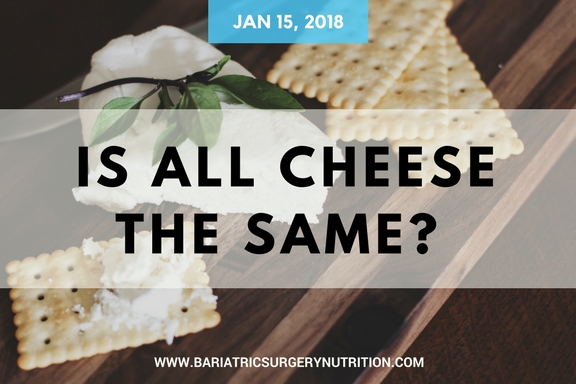Is all cheese the same?

Laughing Cow spreadable cheese triangles versus Philadelphia cream cheese? Is there really a difference? What about harder cheeses?
Many of our patients seem to often choose the creamier spreadable cheeses after WLS or bariatric surgery. But are they the best options?
Let’s go through the nutrition facts together. We’ve also added in brick cheese and ricotta cheese for comparison.
|
Nutrient |
Laughing Cow cheese | Philadelphia cream cheese | Brick mozzarella cheese |
Ricotta cheese |
| Portion |
2 triangles (33g) |
2 tablespoons (30g) | 3 cm cube (30g) |
2 tablespoons (31g) |
| Calories (kcal) | 70 | 100 | 90 | 45 |
| Fat (g) | 6 | 10 | 6 | 3 |
| Saturated fat (g) | 3.5 | 6 | 4 | 2 |
| Trans fat (g) | 0.2 | 0.4 | 0.2 | 0.1 |
| Sodium (mg) | 310 | 130 | 200 | 35 |
| Carbohydrates (g) | 2 | 2 | 1 | 1.5 |
| Protein (g) | 3 | 2 | 8 | 3 |
| Vitamin A (%) | 6 | 12 | 6 | 3 |
| Vitamin C (%) | 0 | 0 | 0 | 0 |
| Calcium (%) | 10 | 4 | 20 | 5 |
| Iron (%) | 0 | 0 | 0 | 0 |
|
Ingredients |
Modified milk ingredients, cheeses, sodium phosphates , citric acid. | Milk ingredients, salt, bacterial culture, carob bean gum, sorbic acid. | Pasteurized milk, modified milk ingredients, bacterial culture, salt, calcium chloride, microbial enzyme. |
Pasteurized milk and whey, lactic acid, salt, maltodextrin, mono and diglycerides, guar gum, carrageenan, carob bean gum |
| Protein:calorie ratio | 1:23 | 1:50 | 1:11 | 1:15 |
So what’s the verdict? Which cheese product is the best nutritionally?
Brick-style cheese (any kind, e.g. mozzarella, cheddar, etc.) and ricotta cheese are the healthier choices compared to the creamy spreadable cheeses.
And who is the winner between Laughing Cow and Philadelphia?
Laughing Cow.
How did we come to these conclusions?
Although the brick cheese has a calorie content similar to cream cheese, it boasts more protein and more calcium. Brick cheeses are also less processed compared to the creamier spreadable cheeses, which are ultra-processed foods. Ultra-processed means that the food has been processed a step further to extend its shelf-life. Processing typically removes many nutrients (some of which are added back in in later steps) and adds a lot of salt (or sodium).
Additionally, the winners can be justified by comparing the protein:calorie ratios (see our previous blog to learn more about this concept: https://bariatricsurgerynutrition.com/2017/07/07/chia-hemp-seeds-are-they-worth-the-hype/).
Looking at the chart above, brick cheese and ricotta cheese have protein ratios of 1:11 and 1:15 respectively, which are lower than the ratios of Laughing Cow cheese (1:23) and Philadelphia cream cheese (1:50). This basically means that brick cheese and ricotta cheese provide more protein for less calories.
This doesn’t mean that you can’t have the occasional creamy spreadable cheese with your bagels and toast, but between Laughing Cow cheese and Philadelphia cream cheese, choose Laughing Cow cheese more often. Although it has more sodium, it has a bit more protein for less calories and fat. To add a protein boost to both of these spreadable cheeses, add a couple slices of smoked salmon or deli meat.
Everything in moderation!
– Lisa & Monica
P.S. We love ricotta cheese because it is a fairly spreadable cheese like cream cheese, but the perk is that you can flavour it however you please. Prefer salty cheese? Add a sprinkle of salt. Prefer a sweeter spread for your morning toast? Sprinkle some sugar, or a drizzle of honey or maple syrup.
https://bariatricsurgerynutrition.com/2018/01/14/is-all-cheese-the-same/

